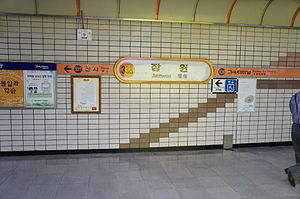
Anguk station, also known as Hyundai E & C station (Korean: 현대건설), is a subway station on the Line 3 of the Seoul Metropolitan Subway. The station is located in the Anguk neighborhood of Jongno District, Seoul and is the nearest subway station to the Insa and Samcheong neighborhoods. The station is also near the ancient royal residence of Unhyeongung.

Yangjae Station is a station on the Seoul Subway Line 3 and Shinbundang Line. It was the southern terminus of Line 3 until October 30, 1993, when the line was extended to Suseo station, and it became a transfer station with the Shinbundang Line on October 28, 2011. It is located in Yangjae-dong, Seocho and Gangnam District, Seoul.

Daechi Station (Korean: 대치역) is a station on the Seoul Subway Line 3. It is located in Daechi-dong, Gangnam-gu, Seoul. It was named after a former village in the area, Hanti (한티), as Daechi is the Chinese reading of the hanja. The name of the station is Chinese characters, meaning "big hill."

Sinsa station is a station on the Seoul Subway Line 3 and the Shinbundang Line. It is located in Sinsa-dong, Gangnam-gu and Jamwon-dong, Seocho-gu, Seoul. It will serve as the northern terminus of the Wirye–Sinsa Line when it is opened in 2025.

Maebong Station is a station on the Seoul Subway Line 3. It is located in Dogok-dong, Gangnam-gu, Seoul and was named after the nearby Maebongsan mountain.

Myeong-dong Station is a station on the Seoul Subway Line 4. This station is located in Jung-gu, Seoul.

Seocho District is one of the 25 local government districts which make up the city of Seoul, South Korea. Seocho is a part of the Gangnam region, along with the Gangnam district of Seoul. Seocho District ranks as one of the richest neighborhoods in South Korea and among the most expensive areas in Seoul with an average sales price of 47.75 million South Korean won per 3.3 square meters. Many of the wealthiest residents are concentrated in the three Gangnam districts including Seocho, known as Gangnam School District Eight.

Seorae Village (Korean: 서래마을), sometimes nicknamed "Montmartre", due to its hilltop location, or sometimes "French Village", is a small, affluent French ethnic enclave in Banpo-dong & Bangbae-dong, Seocho District, Seoul, South Korea. It is home to about 560 French people, roughly 40% of the French community in South Korea. Most of them are employees of French corporations doing business in the country. The majority (370) of the French population are children.

Ichon Station is a station in Yongsan-gu, Seoul on Seoul Subway Line 4 and the Gyeongui–Jungang Line. This station is the closest to the National Museum of Korea, situated in the interior of Yongsan Family Park. It also serves eastern Ichon-dong, home to the largest Japanese community in South Korea with some 1,300 Japanese residents.

Express Bus Terminal Station is a station on the Seoul Subway Line 3, Line 7, and Line 9. The stations are located in the Greater Gangnam Area, Banpo-dong, Seocho District, Seoul, Korea.
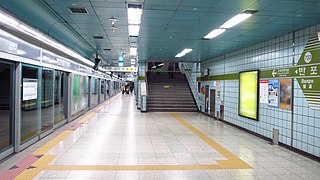
Banpo Station is a metro station on Seoul Subway Line 7 located in Jamwon-dong, Seocho-gu, Seoul. Despite its name, the station is not located in Banpo-dong, but instead in Jamwon. It has 6 entrances that they are all right side entrance and they have screen doors right before entering the train. It takes 4~8 minutes between 2 trains and next stations are Nonhyeon and Seoul Express Bus Terminal. It is only 500m long between Banpo station and two other Stations next to it. The station number is 733.

Sungshin Women's University Station is a station on the Line 4 of the Seoul Subway and Ui LRT in Seoul, South Korea. As its name indicates, it serves the nearby Sungshin Women's University.
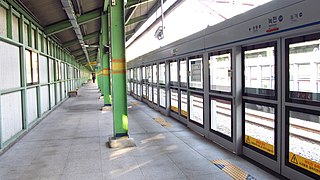
Nokcheon station (Korean: 녹천역) is a metro station on Seoul Subway Line 1 in South Korea. It is located in the northern end of the city.

Jihaeng Station is a ground-level metro station on Line 1 of the Seoul Subway in Jihaeng-dong, Dongducheon, South Korea. It opened on January 30, 2005, to services on the Gyeongwon Line and services on the Seoul Metropolitan Subway began calling here on December 15, 2006. The station offers access to Dongducheon Foreign Language High School, Central Middle and High School, Jihaeng Elementary School, Science Tower and Songnae-dong Office, among other places.
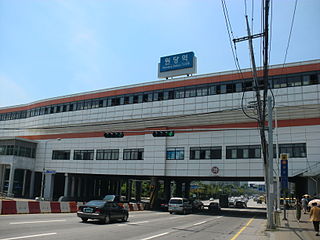
Wondang Station is on Seoul Subway Line 3 in Goyang, Gyeonggi-do. Goyang City Hall is nearby. There is a lot of building work in the area undertaken by SK, Daewoo and other companies; including many apartment complexes, shopping malls and a multiplex cinema.

Jamwon-dong is a dong, neighbourhood of the greater Gangnam area Seocho-gu in Seoul, South Korea. Until 1988, Jamwon-dong was under the jurisdiction of Gangnam-gu. Jamwon-dong is popular for its mulberry trees and silkworms, whose cocoon is used to make fabric for clothing. As a legal-status neighborhood, Jamwon-dong includes Banpo 3-dong and Jamwon-dong.

Banpo-dong is a dong, neighborhood of Seocho-gu, the greater Gangnam area in Seoul, South Korea. Banpo-dong is divided into five different dong which are Banpobon-dong, Banpo 1-dong, 2-dong, 3-dong and 4-dong.

Deokjeong Station is a station in Seoul Subway Line 1. On October 15, 1911, the service started. In 2006, it started to operate the metropolitan train.
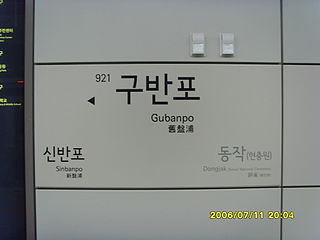
Gubanpo Station is a railway station on Line 9 of the Seoul Subway.

Hangang Park (Korean: 한강공원) is a park that consists of 12 parks in Seoul, South Korea. It consists of Gwangnaru Park, Jamsil Park, Ttukseom Park, Jamwon Park, Ichon Park, Banpo Park, Mangwon Park, Yeouido Park, Nanji Park, Gangseo Park, Yanghwa Park, and Seonyudo Park.
